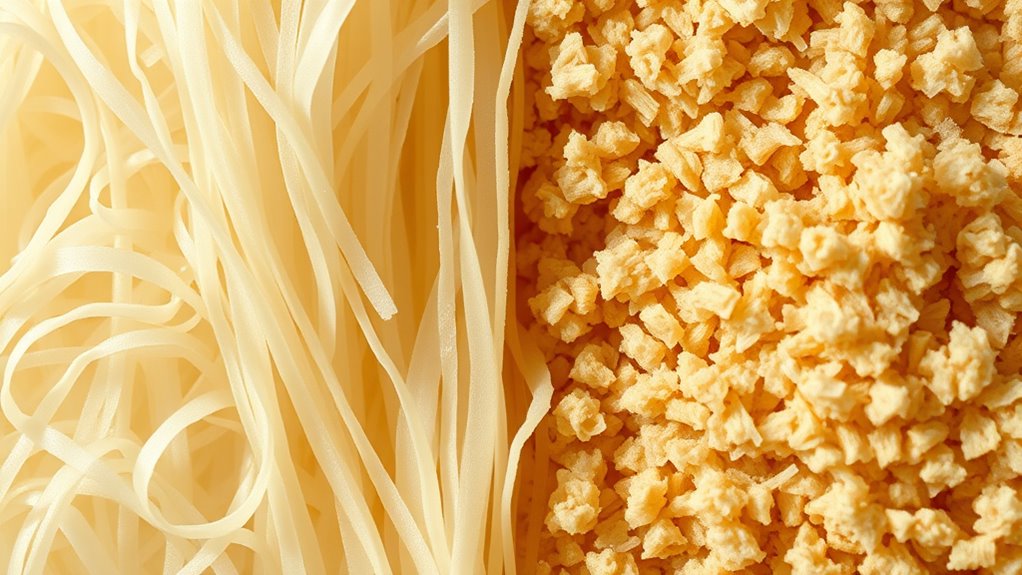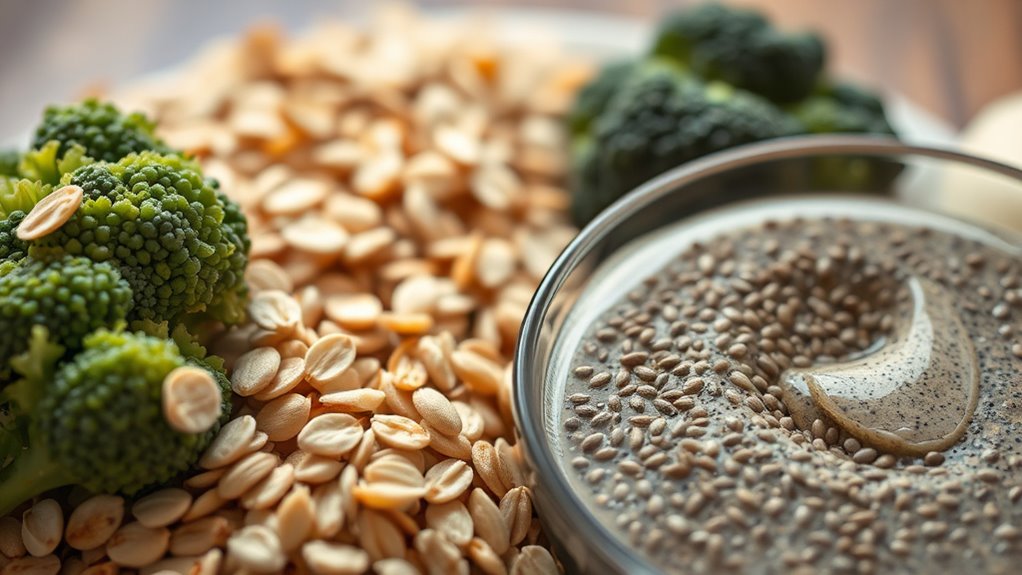Understanding fiber can help improve digestion and reduce gas. Soluble fiber dissolves in water, forming a gel that feeds gut bacteria and boosts overall health, but it can cause gas and bloating if your intake increases too quickly. Insoluble fiber adds bulk to stool, promoting regularity without as much gas, but sudden increases may still lead to discomfort. By balancing both types, I can support my gut health better—stay with me for more insights.
Key Takeaways
- Soluble fiber ferments in the gut, producing gases that can cause bloating and flatulence.
- Insoluble fiber adds bulk but generally causes less gas, aiding regularity without significant fermentation.
- Increasing soluble fiber intake gradually helps minimize excessive gas and digestive discomfort.
- Both fiber types contribute to gut health but have different effects on gas production.
- A balanced diet with varied fiber sources can reduce gas while supporting digestion.

Have you ever wondered what fiber really is and why it’s so important for your health? I used to think fiber was just about staying regular, but over time, I learned that fiber plays a much bigger role, especially when it comes to fiber digestion and gut health. When I first started paying attention to my diet, I realized that understanding the different types of fiber—soluble and insoluble—helped me make smarter choices and eased some digestive issues I’d been struggling with.
Soluble fiber dissolves in water, forming a gel-like substance in your digestive system. It’s found in foods like oats, apples, and beans. I noticed that consuming more soluble fiber helped stabilize my blood sugar levels and lowered my cholesterol. But what truly caught my attention was how it interacts with my gut health. Soluble fiber is a prebiotic, which means it feeds the beneficial bacteria in my gut. This fermentation process produces short-chain fatty acids that nourish my intestinal lining and promote a healthy microbiome. I realized that this is how soluble fiber supports overall gut health—by fostering a balanced environment that aids digestion and reduces inflammation.
Soluble fiber supports gut health by feeding beneficial bacteria and producing nourishing fatty acids.
In contrast, insoluble fiber doesn’t dissolve in water. Instead, it adds bulk to your stool, making it easier to pass through your digestive tract. Foods like whole wheat, nuts, and vegetables like carrots and celery are rich in insoluble fiber. I found that increasing my intake of insoluble fiber helped alleviate constipation and kept my digestive system moving smoothly. It’s like a broom that sweeps through your intestines, preventing sluggishness and promoting regularity. But here’s the thing I learned: because insoluble fiber speeds up transit time, it can sometimes cause gas or bloating if you suddenly eat a lot of it. That’s why I gradually increased my fiber intake and paid attention to how my body responded.
Understanding the balance between soluble and insoluble fiber has been key for me. Both types support my gut health, but they do so in different ways. Soluble fiber nurtures my gut bacteria and improves digestion, while insoluble fiber keeps things moving physically. Incorporating both types of fiber ensures a healthy microbiome and optimal gut function. When I eat a varied diet with plenty of fruits, vegetables, oats, and nuts, I feel better—less bloated, more regular, and with a healthier gut overall. It’s pretty amazing how fiber, often overlooked, can have such a profound effect on my digestive system and overall well-being.
Frequently Asked Questions
Can Fiber Intake Improve Overall Digestive Health Beyond Gas?
Increasing your fiber intake can boost your overall digestive health by supporting a healthy gut microbiome, which plays a crucial role in digestion and immunity. Fiber acts as a natural detox, helping to cleanse your system and improve bowel movements. I recommend gradually adding more fiber-rich foods to avoid gas and guarantee your gut adapts well, leading to better digestion and overall well-being.
Are There Specific Foods That Contain Only Soluble or Insoluble Fiber?
Did you know some foods contain only soluble or insoluble fiber? For soluble fiber, think oats, beans, and citrus fruits—these are excellent dietary sources. Insoluble fiber comes from whole grains, nuts, and vegetables like carrots and celery. While many foods offer a mix, focusing on these fiber-rich foods can help you target specific fiber types. Incorporating both guarantees better digestion and overall health.
How Does Fiber Consumption Affect Individuals With Irritable Bowel Syndrome?
Fiber consumption can really impact those of us with IBS. I’ve found that a low-FODMAP diet helps manage my symptoms, as certain fibers trigger sensitivity and IBS flare-ups. Soluble fiber is usually gentler on my gut, while insoluble fiber sometimes worsens symptoms. I recommend listening to your body, slowly increasing fiber intake, and consulting a healthcare professional to find what works best for your fiber sensitivity and IBS management.
Can Fiber Intake Influence Other Health Conditions Like Heart Disease?
Fiber truly is a hero in disguise. It can lower cholesterol and aid weight management, reducing the risk of heart disease. I’ve seen how increasing fiber intake can make a significant difference in overall health. By incorporating more soluble fiber, like oats or beans, you support heart health and control weight naturally. So, fiber isn’t just about digestion; it’s a powerful tool for long-term wellness.
What Are the Best Ways to Increase Fiber Intake Safely?
To increase fiber intake safely, I recommend starting with small amounts and gradually increasing to avoid gas or bloating. Incorporate more fiber-rich foods like fruits, vegetables, and whole grains into your meals. If needed, fiber supplements can help, but always opt for a gradual increase to give your body time to adjust. Stay hydrated, and listen to your body’s signals as you boost your fiber intake.
Conclusion
In the end, understanding soluble and insoluble fiber is like having a map to better digestion and overall health. They work together like a team, supporting your gut and keeping things moving smoothly. Think of fiber as a loyal friend, guiding you toward wellness with each meal. So, embrace a variety of fiber-rich foods—your gut will thank you, and you’ll feel more energized and balanced, ready to face whatever comes your way.








